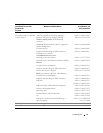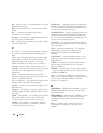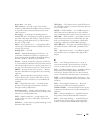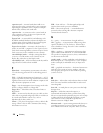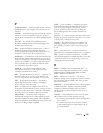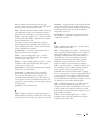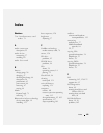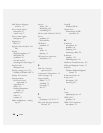
Glossary 179
P
parallel connector — An I/O port often used to connect a
parallel printer to your computer. Also referred to as an
LPT port.
partition — A physical storage area on a hard drive that is
assigned to one or more logical storage areas known as
logical drives. Each partition can contain multiple logical
drives.
PC Card — A removable I/O card adhering to the
PCMCIA standard. Modems and network adapters are
common types of PC Cards.
PCI — peripheral component interconnect — PCI is a
local bus that supports 32-and 64-bit data paths,
providing a high-speed data path between the processor
and devices such as video, drives, and networks.
PCI Express — A modification to the PCI interface that
boosts the data transfer rate between the processor and
the devices attached to it. PCI Express can transfer data at
speeds from 250 MB/sec to 4 GB/sec. If the PCI Express
chip set and the device are capable of different speeds,
they will operate at the slower speed.
PCMCIA — Personal Computer Memory Card
International Association — The organization that
establishes standards for PC Cards.
PIN — personal identification number — A sequence of
numerals and/or letters used to restrict unauthorized
access to computer networks and other secure systems.
PIO — programmed input/output — A method of
transferring data between two devices through the
processor as part of the data path.
pixel — A single point on a display screen. Pixels are
arranged in rows and columns to create an image. A video
resolution, such as 800 x 600, is expressed as the number
of pixels across by the number of pixels up and down.
Plug-and-Play — The ability of the computer to
automatically configure devices. Plug and Play provides
automatic installation, configuration, and compatibility
with existing hardware if the BIOS, operating system, and
all devices are Plug and Play compliant.
POST — power-on self-test — Diagnostics programs,
loaded automatically by the BIOS, that perform basic
tests on the major computer components, such as
memory, hard drives, and video. If no problems are
detected during POST, the computer continues the
start-up.
processor — A computer chip that interprets and executes
program instructions. Sometimes the processor is referred
to as the CPU (central processing unit).
program — Any software that processes data for you,
including spreadsheet, word processor, database, and
game packages. Programs require an operating system
to run.
PS/2 — personal system/2 — A type of connector for
attaching a PS/2-compatible keyboard, mouse, or keypad.
PXE — pre-boot execution environment — A WfM
(Wired for Management) standard that allows networked
computers that do not have an operating system to be
configured and started remotely.
R
RAID — redundant array of independent disks — A
method of providing data redundancy. Some common
implementations of RAID include RAID 0, RAID 1,
RAID 5, RAID 10, and RAID 50.
RAM — random-access memory — The primary
temporary storage area for program instructions and data.
Any information stored in RAM is lost when you shut
down your computer.
readme file — A text file included with a software package
or hardware product. Typically, readme files provide
installation information and describe new product
enhancements or corrections that have not yet been
documented.
read-only — Data and/or files you can view but cannot
edit or delete. A file can have read-only status if:
• It resides on a physically write-protected floppy disk,
CD, or DVD.
• It is located on a network in a directory and the
system administrator has assigned rights only to
specific individuals.



